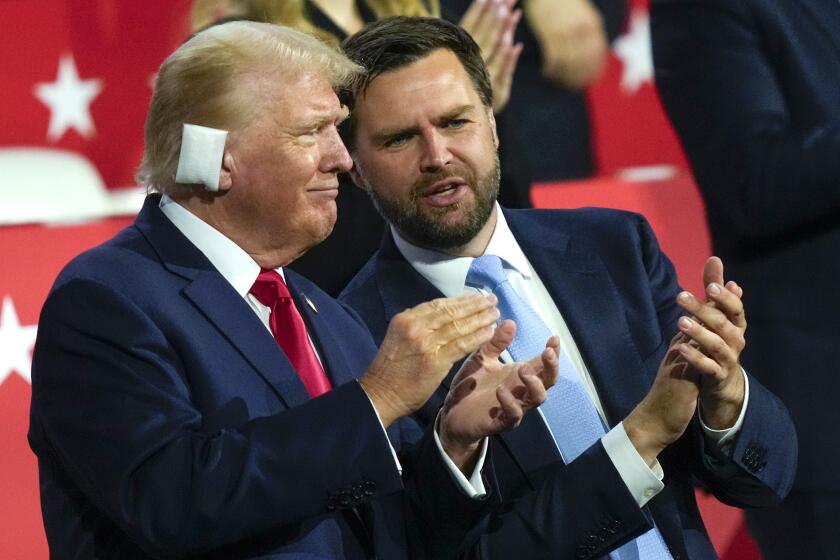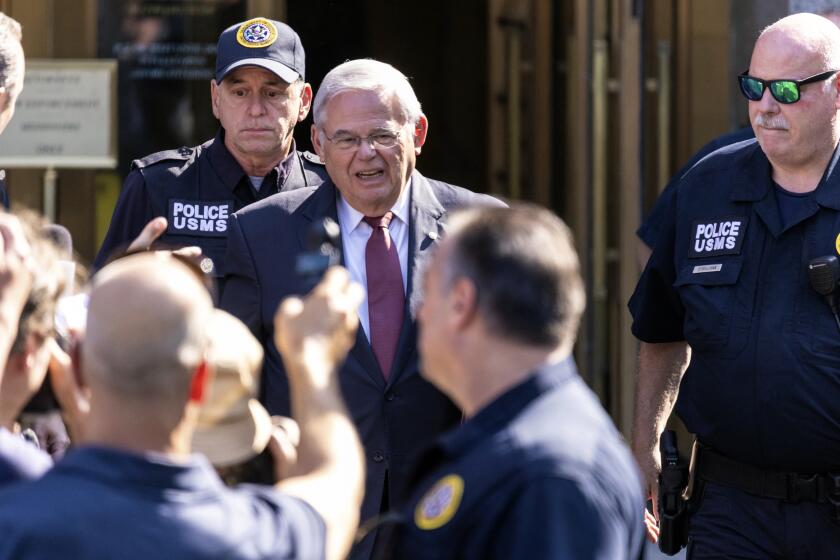News Analysis: Nothing has changed the presidential campaign so far. Will the virus?

For weeks, President Trump‘s campaign did everything it could to depict the coronavirus as something the country had moved beyond: At the Republican convention, speakers referred to the pandemic in the past tense, the president returned to large public rallies and at this week’s debate, he made fun of Joe Biden for always wearing a mask.
Thursday, just after 7:30 p.m., attendees at the annual — now virtual — Al Smith dinner in New York could see Trump on video declaring that “the end of the pandemic is in sight.”
By then, White House officials already knew that Trump’s close aide, Hope Hicks, had tested positive for the virus. Within hours, the president and First Lady Melania Trump disclosed that they had, as well.
That news threw yet another level of uncertainty into a campaign year filled with unforeseen events.
Get our L.A. Times Politics newsletter
The latest news, analysis and insights from our politics team.
You may occasionally receive promotional content from the Los Angeles Times.
Whether the news will change the race, however, is another question entirely. For all the huge changes of the past year, the Trump-Biden race has set records for stability. If you’re betting on a big shift now, better get good odds.
Volatile news hits a stable race
Recently, the veteran Democratic pollster Peter Hart sent a message to his mailing list with a slide showing major news headlines of the year juxtaposed with the results of two NBC/Wall St. Journal polls, which he oversees with Republican pollster Bill McInturff.
The two surveys — one from January, the other from September — showed almost identical results for the presidential race. Hart’s conclusion: The world has changed, the race hasn’t.
He could have gone back further. In hypothetical matchups in 2017 — months before Biden entered the race — the former vice president led Trump by about the same amount he does in current polling averages, about 8 percentage points in the fivethirtyeight.com average.
In recent memory, no presidential race has showed such remarkable stability, and certainly not against the backdrop of news that has altered so many lives.
This past week has seen two news events that, in other times, might have transformed the presidential race — a televised debate thrown into chaos by Trump’s constant interruptions and the news of Trump’s diagnosis.
We won’t know for some days whether either will change public opinion: Accurate polls require a few days, at minimum. But the smart starting point would be to assume that any change will be on the margins.
Why? A re-election campaign almost always serves as a referendum on the incumbent. And with this incumbent, most voters appear to have made up their minds early on.
Since he started in office, a majority of the public has never given Trump a positive rating for his job performance, something that’s been true for no other president. Nor has his standing ever fallen much below 40%. Trump’s core supporters provide a solid floor, and his many detractors a firm ceiling. His standing fluctuates only in the narrow space between.
That lack of change was true to some extent for President Obama‘s ratings as well, indicating that the stability reflects the deeply divided nature of the country’s politics, not just the personality of the current incumbent. Obama, however, was significantly more popular, and his ratings, while unchanging by historical standards, were a roller coaster compared to Trump’s.
The public verdict on Trump’s presidency registered clearly in the 2018 midterm elections. Republicans gained some ground in rural areas, but their support collapsed in suburbs from Orange County to Long Island. The results handed control of the House back to the Democrats, giving them one of their largest gains since World War II, but also saw Republicans win Senate races in more conservative, rural states.
A lot of people vote in presidential races who don’t take part in midterms, of course, but so far the evidence all points to relatively equal increases on both sides of the partisan divide, with the same basic pattern holding true: Continued growth in suburban support for Democrats threatens not only Trump, but Republican incumbents in Arizona, Georgia, Texas and even South Carolina. But Trump’s strong hold on his base has kept him in the race in major battleground states.
And that’s why even if the news events of this week yield only marginal changes in the race, they can’t be dismissed as unimportant. Trump is losing the race, but he remains within striking distance in most of the key battlegrounds. A shift of a few points in his direction could suddenly put him back in contention, just as a shift of a few points toward Biden could turn a modest Democratic lead into something closer to a rout.
Which is the more likely of the two? The Tuesday night debate almost surely hurts Trump at least somewhat. Polls so far all indicate that voters by a fairly large margin thought Biden did better and came away with at least a slightly improved impression of him. Trump’s belligerent tone and constant hectoring of both Biden and the moderator, Chris Wallace, played to his base but alienated the sort of swing voters he needs to attract, according to political strategists in both parties.
Trump’s illness — he so far has mild symptoms of COVID-19, White House Chief of Staff Mark Meadows said — could cause some voters to feel sympathy toward him. But it also severely undermines a pillar of his campaign, the idea that the country has put the virus in the rear-view mirror and that normality lies just around the bend. Moreover, the diagnosis will put Trump out of action for at least a few days, longer if his symptoms worsen, at a point when he badly needs a comeback.
Thursday morning, before Hicks’ diagnosis, Trump was on a trajectory toward defeat. The only thing that’s changed for sure since then is that if the campaign does end with his being rejected by voters, Trump now has a ready excuse to explain his failure: I was on the verge of a comeback, then I got sick.
Enjoying this newsletter? Consider subscribing to the Los Angeles Times
Your support helps us deliver the news that matters most. Become a subscriber.
The latest from the campaign trail
Tuesday’s debate dominated the campaign until the president’s coronavirus diagnosis overtook it. If you missed parts of the controversy and need to catch up, here’s a refresher:
— Jim Rainey and Melissa Gomez took a close look at the pivotal exchange in which Trump, prodded to condemn white supremacists, instead told the Proud Boys to “stand back and stand by.”
— Trump has spent nearly two years looking for an attack line against Biden that would significantly dent the former vice president’s standing in voters’ eyes. At the debate, he unloaded all of them at once, but to little avail, Janet Hook wrote in her analysis.
— Trump had hoped to demonstrate to voters that Biden wasn’t up to the job, but when the moment came, “it was Trump, not Biden, who looked off-balance and out of practice,” Doyle McManus wrote.
— Matt Pearce examined the history of Trump’s relations with white supremacist groups.
— In the aftermath, Republicans feared the focus on white supremacists would significantly damage their candidates up and down the ballot, Hook, Eli Stokols and Melanie Mason wrote.
— In Georgia and North Carolina, voters of color gave their reactions to Jenny Jarvie and Brittny Mejia.
— And Noah Bierman reported from Iowa, a state where Trump is in unexpected trouble. Trump won handily in Iowa in 2016, but his handling of the coronavirus now has him running out of time.
— Steve Battaglio interviewed Wallace, who said he was “disappointed” in how the debate unfolded but thought it told voters a lot about the two candidates. “It may not have been pretty, but it was revealing,” Wallace said.
The latest from Washington
Republican Senate leaders have grown increasingly worried about their majority as polls show GOP incumbents in Georgia, South Carolina and Iowa in tight races.
Hook took a look at nine key Senate races to watch.
In the meantime, the Senate continues to prepare for confirmation hearings for Trump’s Supreme Court nominee, Amy Coney Barrett. One key issue will be her position on the constitutionality of the Affordable Care Act. Barrett may have provided a clue in a moot court proceeding she participated in just a week before the death of Justice Ruth Bader Ginsburg.
As Jennifer Haberkorn reported, Barrett’s position there wasn’t what the administration would hope for.
Haberkorn also looked at the debate among Democrats on whether to get rid of the Senate filibuster if they gain control in the election.
The latest from California
Gov. Gavin Newsom continues to get high marks for his handling of the coronavirus, and that’s buoyed his standing with voters even though they don’t like how he’s dealt with homelessness and housing affordability, the latest Berkeley Institute for Governmental Studies poll shows. Phil Willon reports on the findings.
Stay in touch
Send your comments, suggestions and news tips to politics@latimes.com. If you like this newsletter, tell your friends to sign up.
Until next time, keep track of all the developments in national politics and the Trump administration on our Politics page and on Twitter at @latimespolitics.
Get the L.A. Times Politics newsletter
Deeply reported insights into legislation, politics and policy from Sacramento, Washington and beyond. In your inbox three times per week.
You may occasionally receive promotional content from the Los Angeles Times.




